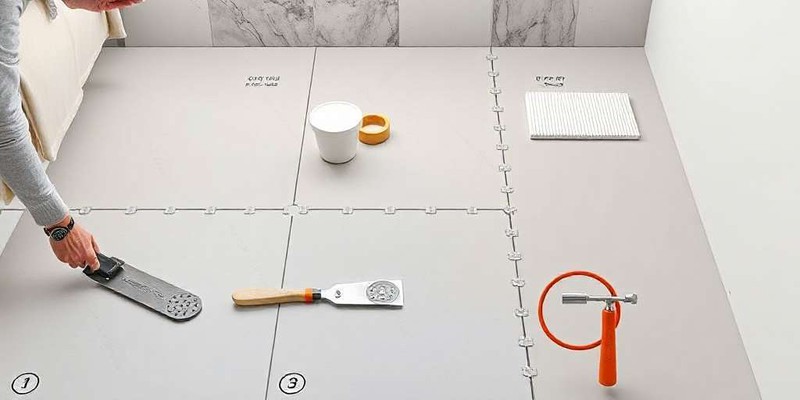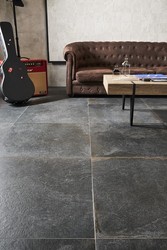How to lay porcelain stoneware: A step-by-step guide for beginners
Porcelain stoneware is a ceramic material that combines aesthetics and functionality. Its low porosity and resistance make it ideal for floors and walls, both indoors and outdoors. Laying porcelain stoneware requires proper preparation and the use of appropriate tools. This article offers a detailed guide on the laying process, as well as best practices for achieving a perfect finish.
Understanding Porcelain Stoneware
To understand porcelain stoneware, it is important to know its characteristics and how it differs from other ceramic materials. This knowledge is essential to appreciate its quality, properties and applications in various constructions.
Characteristics of porcelain stoneware
Porcelain stoneware is characterized by its low porosity, which gives it high resistance to moisture and stains. This material is produced from a mixture of minerals that are pressed and fired at high temperatures, resulting in a dense and durable product. Some of its most notable features are:
Low water absorption: With less than 0.5% absorption, porcelain stoneware is ideal for wet areas, avoiding problems with mold and deterioration.
Great resistance: It is more robust than conventional ceramics, resisting impacts and abrasions, making it suitable even for commercial and outdoor spaces.
Variety of finishes: It can be found in numerous textures and colors, including imitations of stone, wood and other natural materials.
Ease of maintenance: The surface of porcelain stoneware is easy to clean and does not retain dirt, which simplifies its daily care.
Dimensional stability: Its resistance to temperature changes minimizes deformations and cracks.
Differences with other ceramic materials
When comparing porcelain stoneware with other types of ceramic, differences emerge that highlight its advantages. Generally, other ceramic materials can have greater porosity, making them more susceptible to stains and moisture. Some key differences are:
Porosity: Unlike traditional ceramics that can have high absorption, porcelain stoneware is virtually impermeable.
Durability: While other ceramic materials can break easily, porcelain stoneware is highly resistant to impact and wear.
Appearance: Although there are ceramics that imitate other materials, porcelain stoneware offers more realistic and varied finishes.
Applications: It is used in a wider range of environments, both indoors and outdoors, thanks to its resistance to inclement weather.
Advantages of Porcelain Stoneware
Porcelain stoneware is widely valued for its many advantages. This material stands out not only for its aesthetics, but also for its strength, durability and ease of maintenance, making it a preferred choice for indoor and outdoor projects.
Indoor and outdoor resistance
One of the main virtues of porcelain stoneware is its high resistance in both indoor and outdoor environments. This is due to its low porosity and the way it is manufactured. Some of the characteristics that reinforce its resistance are:
- Low water absorption: With an absorption of less than 0.5%, non-slip porcelain stoneware is highly waterproof, which minimizes the risk of stains and deterioration due to humidity.
- Frost resistance: This material is able to withstand extreme weather conditions, making it ideal for cold areas where frost is frequent.
- Durability against impacts: Its composition makes it less susceptible to knocks and falls, avoiding chipping or breaking, which ensures a long useful life.
Aesthetics and variety of imitations
Porcelain stoneware is not only functional, but also provides an elegant and sophisticated look, comparable to more expensive materials. Some of its aesthetic advantages are:
- Wide range of finishes: There is a diversity of designs that imitate textures such as wood, stone, marble and other natural materials, which allows it to adapt to different styles of decoration.
- Customization: The variety of formats and colors facilitates the creation of unique environments, allowing creative patterns in its installation.
- Surface finishes: Porcelain stoneware can offer different finishes, from matte to polished, providing a distinctive touch according to the needs of the project.
Maintenance and durability
The ease of maintenance is another of the strong points of this material. It does not require special treatments and is very easy to clean. Below are some considerations about its maintenance:
- Easy cleaning: The non-porous surface of porcelain stoneware allows stains and dirt to be removed with common cleaning products and a damp cloth, saving time and effort.
- Long durability: Thanks to its resistance to abrasion, porcelain stoneware remains in excellent condition for years, even in high-traffic areas.
- Resistance to chemicals: It is able to withstand various cleaning products without deterioration or alterations in its color or texture.
Necessary Tools
To carry out the installation of porcelain stoneware, it is essential to have an adequate set of tools and materials. Having the right tool not only makes the process easier, but also guarantees a professional and long-lasting finish.
Cutting and setting tools
Tools for cutting and setting tiles are essential throughout the installation process. The main tools to be used are described below:
- Ceramic cutter
The ceramic cutter is essential for making precise cuts in porcelain stoneware tiles. There are different types of cutters, from manual to electric. A manual cutter is recommended for smaller tiles, while an electric cutter is more practical for large formats or when thorough work is required.
- Ceramic pliers
Pliers are ideal for perfecting cuts and adjusting the edges of tiles. They allow for cuts in corners and hard-to-reach areas.
- Rubber mallet
This type of hammer helps ensure that the tiles are laid evenly, preventing them from breaking during the process. It is useful for gently tapping the tiles into place, allowing the adhesive to take effect without causing damage.
Tools for applying adhesives and grout
Proper handling of adhesive and mortar is crucial to the success of the installation of porcelain stoneware. The tools required for these tasks are listed below:
- Notched trowel
This tool is essential for applying the adhesive evenly over the surface. The different notched sizes allow you to adjust the amount of adhesive used, depending on the type of tile and the method of installation.
- Bucket
A bucket is necessary for mixing the adhesive and mortar. It is advisable to have at least two buckets: one for the adhesive and one for the grout.
- Spacers
Spacers are small plastic pieces that are placed between the tiles to ensure that the joints remain uniform. This is essential for an aesthetic and professional finish.
- Rubber trowel
The rubber trowel is used to apply the mortar in the joints between the tiles. Its flexibility allows for correct distribution of the mortar, ensuring that all the joints are well sealed.
- Sponge
A sponge is useful for cleaning the surface of the tiles after applying the grout. It allows you to remove any residue that may interfere with the final appearance of the porcelain stoneware.
- Mixing rod
This utensil is ideal for mixing adhesives and mortars effectively, ensuring proper texture and consistency before application.
Essential Materials
The selection of suitable materials is essential to ensure a correct installation of porcelain stoneware. These materials not only ensure good adhesion, but also contribute to the durability and aesthetic finish of the work carried out.
Recommended Adhesives
The adhesive is one of the most critical materials in the installation of porcelain stoneware. Its choice directly influences the quality and longevity of the installation. To ensure optimal adhesion, it is recommended to use high-quality adhesives. Among the most notable options are:
Class C2TE adhesives: These offer improved resistance characteristics and are ideal for indoor and outdoor environments, guaranteeing greater durability.
Class C2F adhesives: These are commonly used in areas where additional resistance to water and humidity is required, especially in outdoor spaces.
Powder adhesives are the most common option, although there are also pre-mixed alternatives that make them easier to use. It is important to follow the manufacturer's instructions regarding preparation and application, thus ensuring an effective bond between the tiles and the surface.
Surface Preparation
Preparing the surface is a fundamental step in the installation of porcelain stoneware. A suitable base guarantees correct adhesion of the material and prolongs its durability. Below are the actions necessary to achieve an optimal surface.
Cleaning and levelling the floor
Before starting to install the porcelain stoneware, it is essential to ensure that the floor is completely clean and level. This includes removing any material that may interfere with adhesion.
Cleaning the floor: Dust, grease, paint or cement residue must be removed. To do this, a broom, vacuum cleaner or damp mop can be used. It is important to ensure that the surface is free of any kind of residue.
Levelling the floor: The surface should be as even as possible. It is recommended to use a spirit level to check for irregularities. If differences in height are detected, a levelling paste will need to be applied. This is spread with a wide trowel, and it is crucial to follow the manufacturer's instructions regarding drying time.
Solutions for irregularities
Irregularities in the floor can cause long-term problems in the installation of porcelain stoneware. There are various solutions depending on the type of problem detected.
Levelling paste: Ideal for correcting small differences in height. It is applied in thin layers and can be suitable for cement and mortar floors.
Self-levelling mortar: For floors with greater irregularities, self-levelling mortar helps to create a completely flat base. It is important to follow the manufacturer's instructions regarding the amount of product and drying time.
Inserting plasterboard or fibre cement panels: In some cases, if the original floor is very unstable or damaged, panels can be placed over the existing surface to ensure a solid and problem-free base.
Laying Techniques
Porcelain stoneware can be laid using different techniques, each suitable for the format and location of the tiles. It is essential to choose the appropriate technique to ensure a long-lasting and aesthetically pleasing installation.
Thin-bed method
The thin-bed technique is ideal for smaller or medium-sized tiles. It involves applying a mortar about 5 mm thick to the floor using a notched trowel. This method allows for easier handling and fitting of the tiles, ensuring proper adhesion.
The detailed steps for carrying out this method are:
- Prepare the surface ensuring a level and clean base.
- Apply the adhesive evenly over the surface with the notched trowel.
- Lay the tiles starting from the centre of the room towards the walls, to maintain a harmonious pattern.
- Adjust each tile with a rubber mallet, ensuring that they are well seated.
- Use spacers in the joints to maintain an even gap between the tiles.
Double gluing technique
The double gluing technique is recommended for large-format tiles, which can be from 60x60 cm. This method consists of applying adhesive to both the base and the back of the tile, which improves adhesion and ensures that the tiles stay in place over time.
The steps to implement this technique are as follows:
- Check that the surface is level and clean before beginning the installation.
- Apply the adhesive to the surface using a notched trowel, covering the entire area.
- Additionally, apply a layer of adhesive to the back of each tile before installation.
- Place the tiles carefully, pressing lightly to ensure that they adhere properly.
- Continue using spacers to maintain the proper separation in the joints between tiles.
Step-by-Step Installation Process
Correct installation of porcelain stoneware is essential to ensure its durability and performance. Below are the essential steps to carry out this task efficiently and effectively.
Planning the layout
Before you begin the installation process, it is crucial to plan the layout of your tiles. This step involves:
- Defining the desired laying pattern, whether straight, diagonal or random.
- Taking precise measurements of the area to be covered to avoid surprises during installation.
- Marking the position of the tiles on the floor or wall, using chalk or a level, so as to ensure a harmonious layout.
- Considering the dimensions of the chosen tiles and how they fit into the available space.
This advance planning will reduce the need for unforeseen adjustments and cuts during the installation process, thus ensuring a more professional finish.
Applying the adhesive
Once the layout has been planned, the adhesive is applied. This step is essential to ensure that the tiles are held firmly in place. Things to consider are:
Prepare the adhesive according to the manufacturer's instructions, using the mixing bucket and rod to achieve a homogeneous mix.
Using the notched trowel, apply an even layer of adhesive to the surface to be covered, making sure that the correct type of trowel is used for the thickness of the desired layer.
If the double-gluing technique is being used, apply adhesive to the back of the tiles as well before laying them. This provides a better grip.
It is essential to work in small sections to prevent the adhesive from drying before laying the tiles. A working time of 20 to 30 minutes is usually recommended, depending on the environmental conditions.
Laying the tiles
Laying the tiles must be done carefully to maintain proper alignment and spacing between them. The steps include:
- Start from the center of the area, standing at the point where the previously marked reference lines intersect. This helps ensure that the pattern is symmetrical.
- Lay the first tile by gently pressing it down. Use the rubber mallet to adjust it without damaging it.
- Continue laying adjacent tiles, inserting spacers into the joints to maintain an even gap.
- If necessary, use the tile cutter to make cuts along the edges of tiles that do not fit perfectly, ensuring that there are no gaps or uneven spaces.
Once the tile is installed, it is crucial to let the area rest according to the adhesive's instructions to ensure that the tiles are firmly adhered before proceeding with grouting.
Outdoor Considerations
Installing porcelain stoneware outdoors requires special attention to weather conditions and the types of products used. These factors determine the durability and performance of the material in outdoor spaces.
Weather Resistance
Porcelain stoneware is known for its high resistance to different weather conditions, making it an ideal choice for outdoors. Some of the aspects to consider include:
- Extreme Temperatures: This material can withstand temperature variations without damage, which helps prevent the appearance of cracks.
- Humidity: With low water absorption, porcelain stoneware tiles are less prone to mold growth or frost damage.
- UV and Fading: Quality products are designed to resist UV radiation, minimizing color loss over time.
Porcelain Stoneware Options for Facades
Choosing porcelain stoneware for facades can transform the aesthetics of a building. Available options allow designs to be tailored to specific needs and personal preferences:
- Textures and Finishes: There are various ceramic textures that imitate stone, wood or traditional ceramics, offering great versatility in design.
- Tile Format: Large-format tiles are ideal for use as facade cladding, as they reduce visible joints and create a cleaner finish.
- Colours: The range of colours is wide, allowing porcelain stoneware to be combined with the surroundings or existing architecture.
The correct selection of porcelain stoneware, taking into account the external conditions and the necessary maintenance, guarantees not only an effective installation, but also a long service life and a remarkable visual appeal.






Our customers trust us
Opinions of our clients
Receive our news